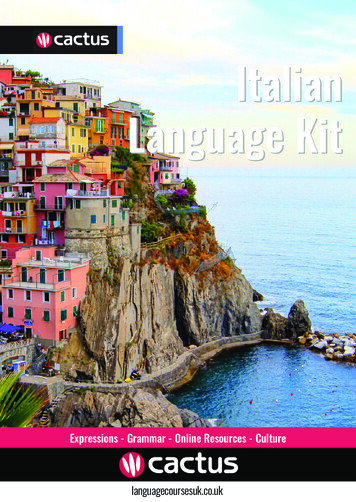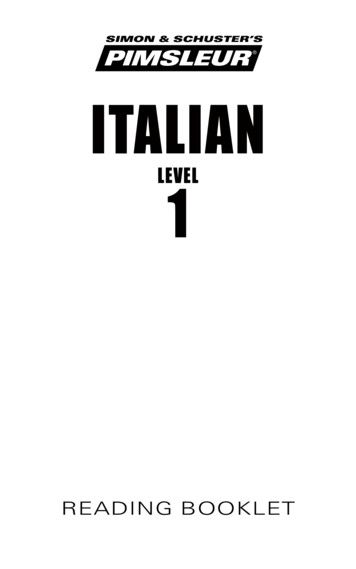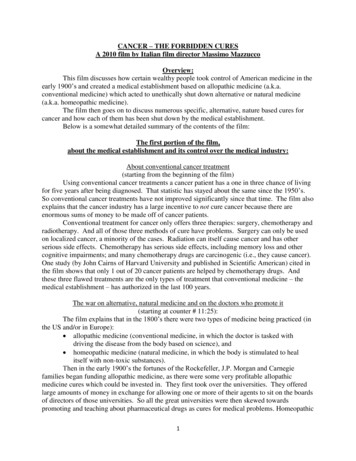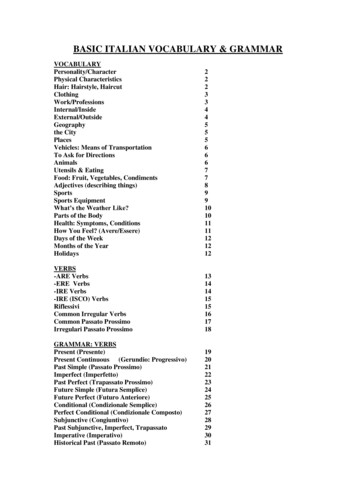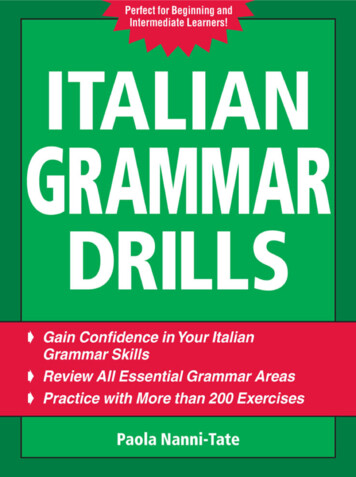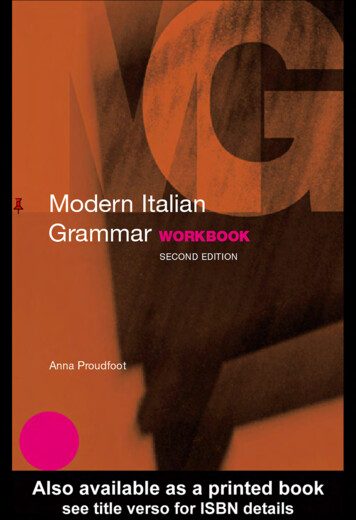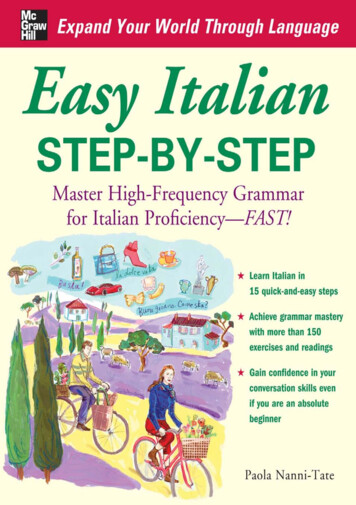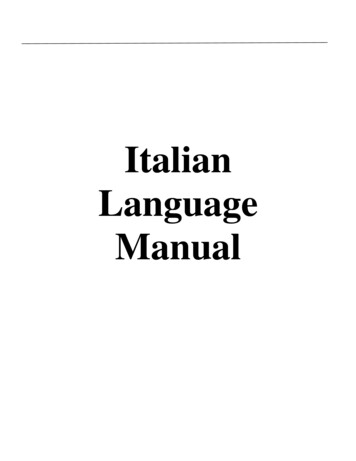
Transcription
ItalianLanguageManual
General Factson Italy
Location: Southern Europe, a peninsula extending intothe central Mediterranean Sea, northeast of TunisiaBorder countries: Austria, France, Holy See (VaticanCity), San Marino, Slovenia, SwitzerlandCapitol: RomeOfficial language: ItalianNatural Resources: coal, mercury, zinc, potash, marble,barite, asbestos, pumice, fluorspar, feldspar, pyrite(sulfur), natural gas and crude oil reserves, fish, arablelandPopulation: 58,133,509Ethnic Groups: Italian (includes small clusters ofGerman-, French-, and Slovene-Italians in the north andAlbanian-Italians and Greek-Italians in the south)Ethnic Composition: Caucasian (97%), North African (1.3%), Black African, East AsianReligions: Roman Catholic 90% (approximately; about one-third practicing), other 10%(includes mature Protestant and Jewish communities and a growing Muslim immigrantcommunity)Government type: RepublicIndependence: 17 March 1861 (Kingdom of Italy proclaimed; Italy was not finally unified until1870)National Holiday: Republic Day, 2 June (1946)
Cultural Aspects
Holidays:DateJanuary 6HolidayEpiphanyApril 25Liberation DayMay 1June 2May DayFestival of the RepublicAugust 15FerragostoNovember 2December 8All Saints DayImmaculate ConceptionDecember 26Feast of St. ys.aspMeaningIs a Christian feast day thatcelebrates the revelation ofGod in human form in theperson of Jesus Christ.Commemorates the liberationof Italy by allied troop inWWII; also remembers thosewho served in the war.Labor DayItaly voted in referendum toabolish the monarchy andbecome a republic governmentCelebrates the rise of Mary upto heaven to join her sonJesus.Celebrates all Catholic saintsCommemorate when Marywas graced by God to lead alife completely free on sin.Marks the day of St. Stephen ,the first marty for the newborn king
Italian Cuisine:The kitchen is undoubtedly a very important part of Italian culture. Known throughout the world,loved and copied continuously been able to bestow joy and pleasure of living at any latitude. Weknow what is the reaction of everyone when, in any chaotic industrial city in the world, tired anddepressed, sees a sign of Italian cooking: my heart warmed.It is a cuisine rich, nutritious and healthy handed down for centuries through family life,especially rural impression and, as such, close to our land, its products throughout the seasons:thus entrusted to genuine and natural ingredients. It 'is filled with wonderful unique dishes ofpasta with vegetables, edible vegetables: ingredients at the root of our traditions, but also ofcountless varieties of meat, just fish in the seas are full of our peninsula, an aromatic cheese andgreat desserts. But, of course, on our table the element of force is the "first course" in its manyvariations, from pasta or soup, soups, various types of soups and stews, risottos, casseroles too.Do not forget, however, that most traditional dishes from the kitchen most common result ofpoor peasants and lower classes, which have resulted, however, over time, real "specialty": thinkof soups stale bread and vegetables, such as ribollita or acquacotta Tuscany, and many recipesbased on ingredients but not exalted lineage have become classics of Italian cuisine absolute.demonstrates that the goodness of a dish depends largely on the magical combination ( always"unique") resulting dall'irripetibile fusion flavors and aromas, cooking times and balancing of theindividual components, personal capacity "creative" and demonstrated accuracy in thepreparation. Sometimes in the kitchen just a detail, a nuance, for exceeding the limits of test as"normal" and make every dish a triumph of taste. The passion, then, is a prerequisite in Italiancuisine without which, as indeed in every aspect of life does not go very far. Despite regionalvariation, this kitchen keeps his dishes "strong" throughout the territory and is capable ofinventing the most important meals when prepared with greater wealth of ingredients for chefsand fine scholars.Italy is also famous for their wine including Barolo, Barbaresco, Brunello Di Montalcino,Barbera, Dolcetto, Corvina, Nero d'Avola, Pinot Grigio and Moscato, to name a few. Inaddition, Italy is famous their desserts and types of coffee. Some of the deserts Italy is famousfor include Tiramisu, cannoli, the cassata Siciliana, marzipan-shaped fruits, the panna cotta,gelato (Italian ice cream abroad), and Sicilian granitas (similar to a snow cone).The following pictures are examples of Italian Cuisine:Gelato Tiramisu Lasagna Pasta FagioliFrom: http://www.italianculture.net/cucina.html
Italian Family Values:The family is the centre of the social structure and provides a stabilizing influence for itsmembers.In the north, generally only the nuclear family lives together; while in the south, theextended family often resides together in one house.The family provides both emotional and financial support to its members.Italian Style:Appearances matter in Italy.The way you dress can indicate your social status, your family's background, and youreducation level.First impressions are lasting impressions in Italy.The concept of 'bella figura' or good image is important to Italians.They unconsciously assess another person's age and social standing in the first fewseconds of meeting them, often before any words are exchanged.Clothes are important to Italians.They are extremely fashion conscious and judge people on their appearance.You will be judged on your clothes, shoes, accessories and the way you carry yourself.Bella figura is more than dressing well. It extends to the aura your project too - i.e.confidence, style, demeanour, etc.Etiquette & Customs in Italy:Meeting EtiquetteGreetings are enthusiastic yet rather formal.The usual handshake with direct eye contact and a smile suffices between strangers.Once a relationship develops, air-kissing on both cheeks, starting with the left is oftenadded as well as a pat on the back between men.Wait until invited to move to a first name basis.Italians are guided by first impressions, so it is important that you demonstrate proprietyand respect when greeting people, especially when meeting them for the first time.
Many Italians use calling cards in social situations. These are slightly larger thantraditional business cards and include the person's name, address, title or academichonors, and their telephone number.If you are staying in Italy for an extended period of time, it is a good idea to havecalling cards made. Never give your business card in lieu of a calling card in a socialsituation.Gift Giving EtiquetteDo not give chrysanthemums as they are used at funerals.Do not give red flowers as they indicate secrecy.Do not give yellow flowers as they indicate jealousyIf you bring wine, make sure it is a good vintage. Quality, rather than quantity, isimportant.Do not wrap gifts in black, as is traditionally a mourning colour.Do not wrap gifts in purple, as it is a symbol of bad luck.Gifts are usually opened when received.Dining EtiquetteIf invited to an Italian house:If an invitation says the dress is informal, wear stylish clothes that are still rather formal,i.e., jacket and tie for men and an elegant dress for women.Punctuality is not mandatory. You may arrive between 15 minutes late if invited todinner and up to 30 minutes late if invited to a party.If you are invited to a meal, bring gift-wrapped such as wine or chocolates.If you are invited for dinner and want to send flowers, have them delivered that day.Table mannersRemain standing until invited to sit down. You may be shown to a particular seat.Table manners are Continental -- the fork is held in the left hand and the knife in theright while eating.Follow the lead of the hostess - she sits at the table first, starts eating first, and is thefirst to get up at the end of the meal.The host gives the first toast.An honored guest should return the toast later in the meal.
Women may offer a toast.Always take a small amount at first so you can be cajoled into accepting a secondhelping.Do not keep your hands in your lap during the meal; however, do not rest your elbowson the table either.It is acceptable to leave a small amount of food on your plate.Pick up cheese with your knife rather than your fingers.If you do not want more wine, leave your wineglass nearly full.Relationships & CommunicationItalians prefer to do business with people they know and trust.A third party introduction will go a long way in providing an initial platform fromwhich to work.Italians much prefer face-to-face contact, so it is important to spend time in Italydeveloping the relationship.Your business colleagues will be eager to know something about you as a person beforeconducting business with you.Demeanor is important as Italians judge people on appearances and the first impressionyou make will be a lasting one.Italians are intuitive. Therefore, make an effort to ensure that your Italians colleagueslike and trust you.Networking can be an almost full-time occupation in Italy. Personal contacts allowpeople to get ahead.Take the time to ask questions about your business colleagues family and personalinterests, as this helps build the relationshipItalians are extremely expressive communicators. They tend to be wordy, eloquent,emotional, and demonstrative, often using facial and hand gestures to prove their point.From: tiquette/italy-country-profile.html
Music:Music has traditionally been one of the great cultural markers of what it means to be ―Italian‖and holds an important position in society, in general, and even in politics. Italy is also widelyregarded as the birthplace of sheet music, after Guido d'Arezzo was responsible for arrangingmusical notes on sheets of paper. The music of Italy range across a broad spectrum, from herrenowned opera to modern experimental classical music; and from the traditional music of themany ethnically diverse region to a vast body of popular music drawn from both native andimported source. Historically, musical developments in Italy in the Middle Ages andRenaissance helped create much music that spread throughout Europe. Innovation in the use ofmusical scales, harmony, notation, as well as experiments in musical theater led directly not justto opera in the late 16th century, but to classical music forms such as the symphony andconcerto, and to later developments in popular music. Today, the entire infrastructure thatsupports music as a profession is extensive in Italy, including conservatories, opera houses, radioand television stations, recording studios, music festivals, and important centers of musicologicalresearch. Musical life in Italy remains extremely active, but very Italian-centered and hardlyinternational. The only main international Italian pop-singers include 1970s pop-diva Mina, whosold 76 million records worldwide in her lifetime, and singer Laura Pausini, who has sold 45million albums and has been dubbed the 'Queen of Italian Pop'.Italy is widely known for being the birthplace of opera. Italian opera was believed to have beenfounded in the early 1600s, in Italian cities such as Mantua and Venice. Later, works and piecescomposed by native Italian composers of the 19th and early 20th centuries, such as Rossini,Bellini, Donizetti, Verdi and Puccini, are amongst the most famous operas ever written and todayare performed in opera houses across the world. La Scala operahouse in Milan is also renownedas one of the best in the world. Famous Italian opera singers include Enrico Caruso, LucianoPavarotti and Andrea Bocelli, to name a few.
GeographicalDistributionLinguisticCommunity
Italian is the official language of Italy, San Marino, Switzerland, Slovenia, Vatican City, andis one of the 23 working languages in the European Union. Other European countries that speakItalian consist of: Belgium, Germany, UK, and France.Outside of Europe, Italian speaking communities can be found in the United States, Canada,Venezuela, Uruguay, Brazil, Argentina, Africa, and Australia.In the United States, Italian speakers are most commonly found in five cities: Boston (90,000),Chicago (60,000), Miami (75,000), New York City (120,000), and Philadelphia (50,000). InCanada there are large Italian-speaking communities in Montreal (100,000) and Toronto(70,000).The geographic distribution of the Italian language in the world: large Italian-speakingcommunities are shown in green; light blue indicates areas where it was understood and spokenduring the Italian colonial period, in the first half of the 20th century.The map below is an example of Dialect of Italy (or Languages of Italy)
DemographyItaly Population has surpassed 60 million as per the 2009 estimates. It is the fourth largestpopulated country of Europe and ranks twenty third in the world chart. And in terms ofpopulation density, the country stands fifth all over Europe. There are 200 persons approxresiding in every square kilometer of land area.Italy, including the islands of Sardinia and Sicily covers an area of 301,338 square km. It is madeup 20 administrative regions including Abruzzi, Calabria, Campania, Emilia-Remagna, Liguria,Lombardia, Marche, Molise, Piemonte, Puglia, Sardegna, Toscana, Trentino-Alto Adige,Umbria, Giulia, Lazio,Valle d'Aosta, Veneto, Sicilia, Friuli-Venezia and Basilicata.Italian Population has been mainly affected by the high birth rate of 9.78 births per 1,000 peopleand relatively high life expectancy and low death rate of 9.82 deaths/1,000 people.Some of the largest populated cities of Italy are Rome, Milan, Naples, Turin, Palermo andGenoa. Among other major Italian cities the most populated having more than 250,000inhabitants are Bologna, Florence, Bari, Catania, Venice and Verona.According to latest reports as per the Italian Statistics Office, the literacy rate among ItalyPopulation is 98% with schooling
Famous Italian opera singers include Enrico Caruso, Luciano Pavarotti and Andrea Bocelli, to name a few. Geographical Distribution Linguistic Community . Italian is the official language of Italy, San Marino, Switzerland, Slovenia, Vatican City, and is one of the 23 working languages in the European Union. Other European countries that speak Italian consist of: Belgium, Germany, UK, and France .File Size: 1MBPage Count: 94
